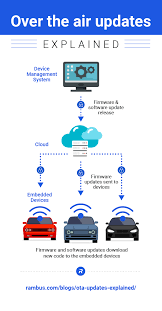We all get these notifications- “please keep your phone plugged in for a download tonight.” It seems like when we go to sleep our smartphones do not. Increasingly, cars are going to be staying awake too. Modern vehicles require software updates during the downtime when there’s more bandwidth and less interruption. This “synchronicity” brings some tricky, new relationships, including “the car that never sleeps.”
With phones, we have learned to accept behind-the-scene downloads. We also implicitly acknowledge that eventually the hardware will not keep up and have to be abandoned. Phone users, tablet owners, and Chromebook owners accept this, probably because the entry price for these devices is commensurate. Expecting your phone (or Chromebook) to have a lifespan of 3 to 4 years is okay, but cars are on the road far longer. In fact, the average age of a car in the US is over 12 years. What will happen when an auto manufacturer no longer wishes to support the device?
Pushing Downloads:
Tesla and app makers have been in the business of pushing software updates to theaw vehicles since the beginning. It’s clever if it’s the cutesy Halloween Ghostbusters download, with strobes lights and spooky audio. But, most downloads are essential. Apparently Tesla has used computer vision to do a lot of things that other car manufacturers do with sensors, such as adaptive cruise control or blind spot monitoring. So, like any learning system, their computer vision needs to be “improved.”
Tesla has yet to set an end date for these updates, but curiously, they do not let owners re-lease their cars. This could be part of a strategy to make sure that vehicles stay compliant. The other method is the brave new world of subscriptions- something that Tesla is already keen on.
Buy a Package:
The automobile industry hopes to convince drivers to “buy” packages. They incur a monthly recurring fee for services that improves or “enhances” the driving experience. In the case of Tesla, it’s the “supervised” self driving package at $99.00 a month.
For General Motors the subscription service is a portal called OnStar, which provides emergency services and roadside support. Although many OnStar services are free using apps, General Motors says they they plan to grow it into a 25 billion business by 2030. But, offering a subscription service is not always straightforward and clean. Last year, BMW ran into a legal wall when they tried to charge customers a subscription for heated seats and remote start features- things that the vehicles already came with.
Iron Out Problems:
But there are more problems to iron out. First, equipping a vehicle with the need for subscriptions means that it needs to have adequate and frequent connectivity. It cannot be “off the road” or the grid for too long. It’s another reason that “the car never sleeps.”
Second, the legacy carmakers, more so than Tesla, are good at making mechanical things- but less adept performing as Silicon Valley companies. This probably explains why the Detroit automakers and overseas ones have all set up West Coast design. They need to recruit and retain the software engineers.
Third, if you drive an electric vehicle, these “enhanced” services are more a necessity than a preference. Mapping services are necessary to locate charging stations, and other software is needed to handle the changing protocol and handshake with a charging station.
Who Controls the Downloads?
There’s been a recent and interesting twist to subscriptions, and it comes down to who owns the screen in your (new) vehicle. General Motors (GM) cars, like Tesla, are no longer able to access the apps for Apple Play and Android Auto. Instead, GM vehicles offer their own Ultifi software. It allows the cars to get over-the-air updates, plus Google maps and Spotify. Behind the scenes Ultifi can provide access for those remote software upgrades and the opportunity to track both vehicles and owners.
The vast majority of today’s drivers are accustomed to mechanically operated cars, not ones run by computers. So, it’s going to require some re-education to make them aware of the need for wifi and downloads. Based on their past experience, cars should not be subject to security flaws and hacks. They don’t realize that their personal data “lives” are captured as they drive, so it has to be protected with cyber-security patches. Sometimes the patches are necessary to repair bad design: In 2023, Kia and Hyundai release a remote update to four million vehicles at risk of being targeted by thieves, when a TikTok video showed how particular models could be stolen. The forthcoming issue, when there is no obvious design flaw, is how long an automaker will continue to provide updates, and who will be paying for them.

